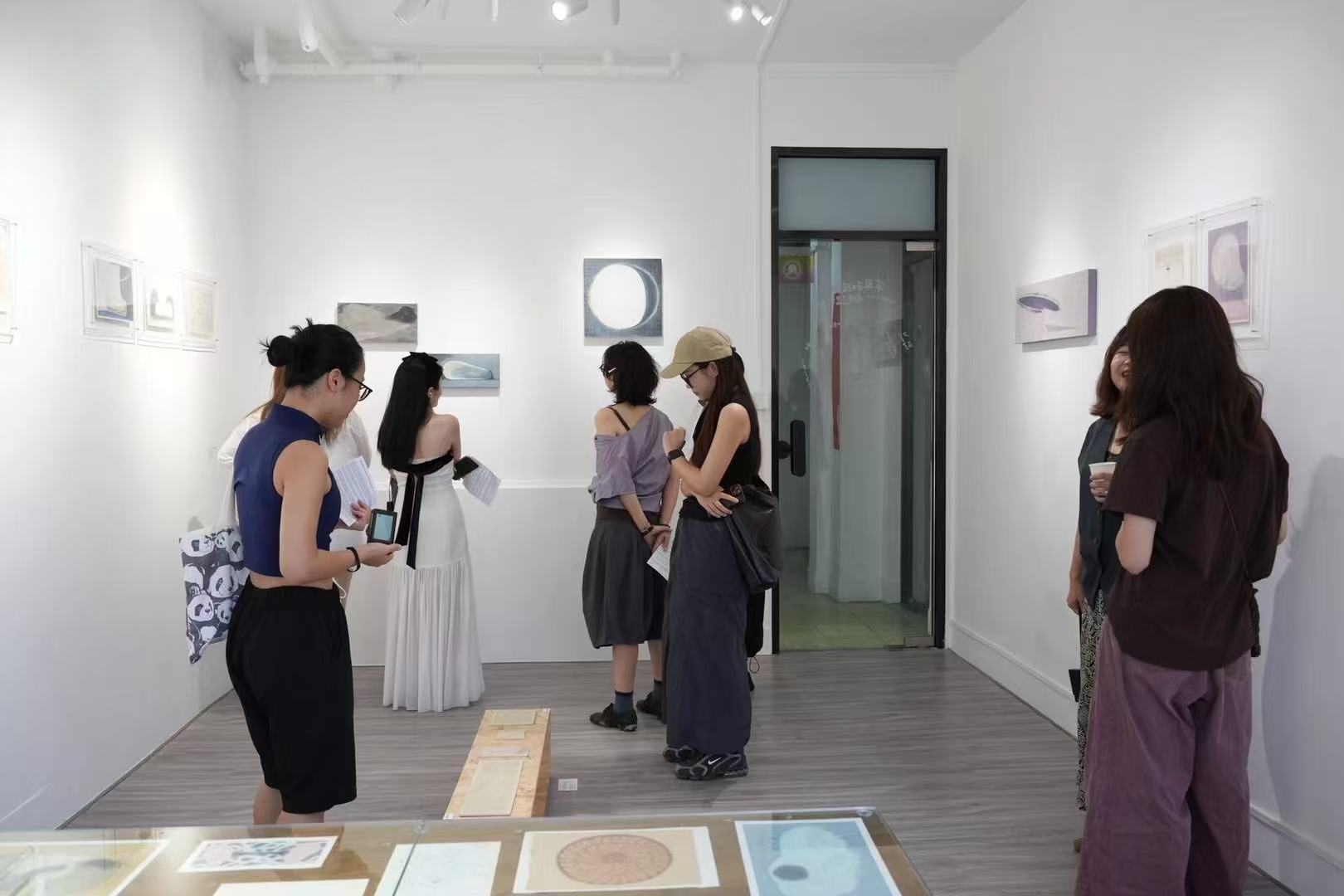
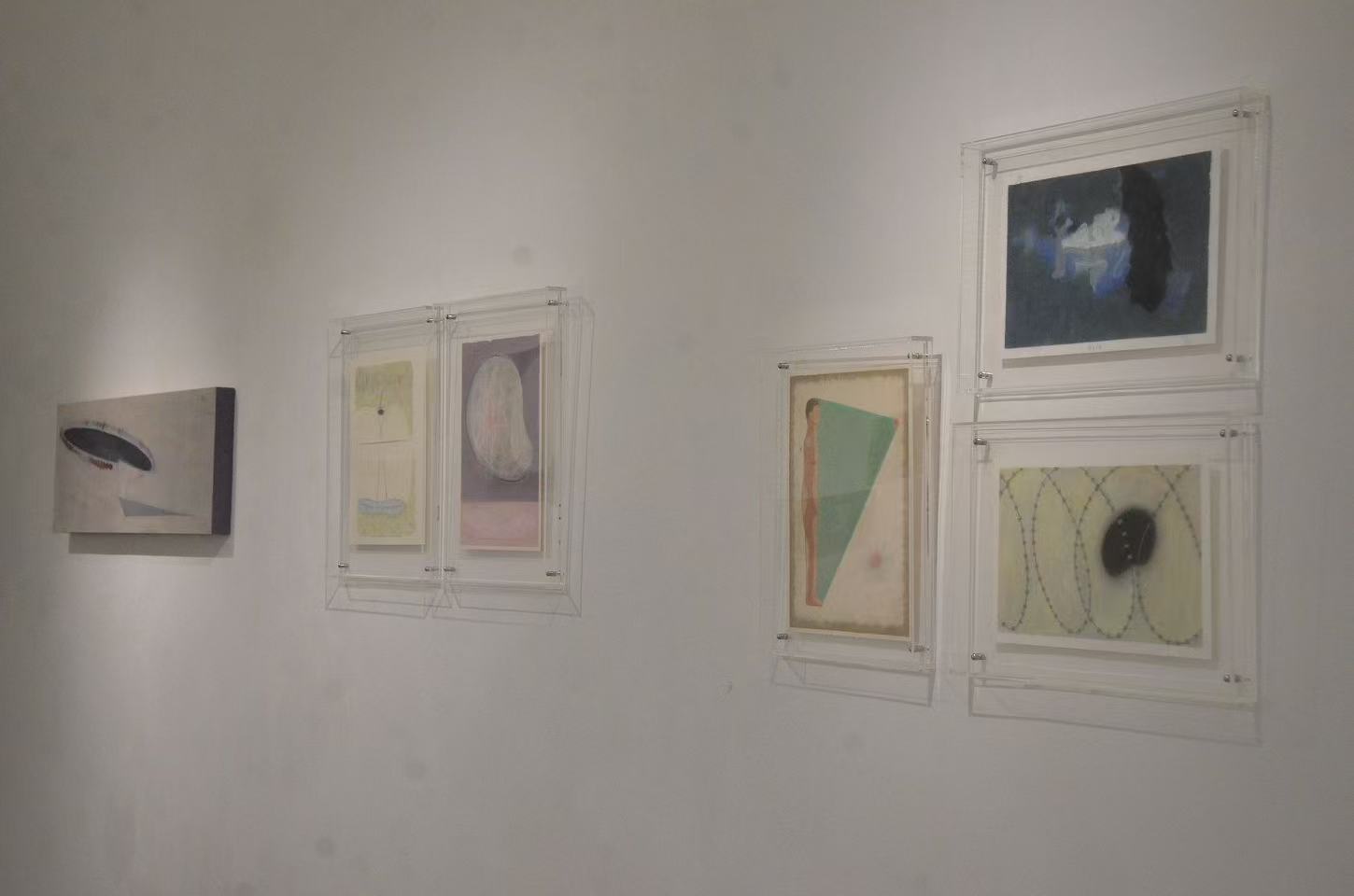
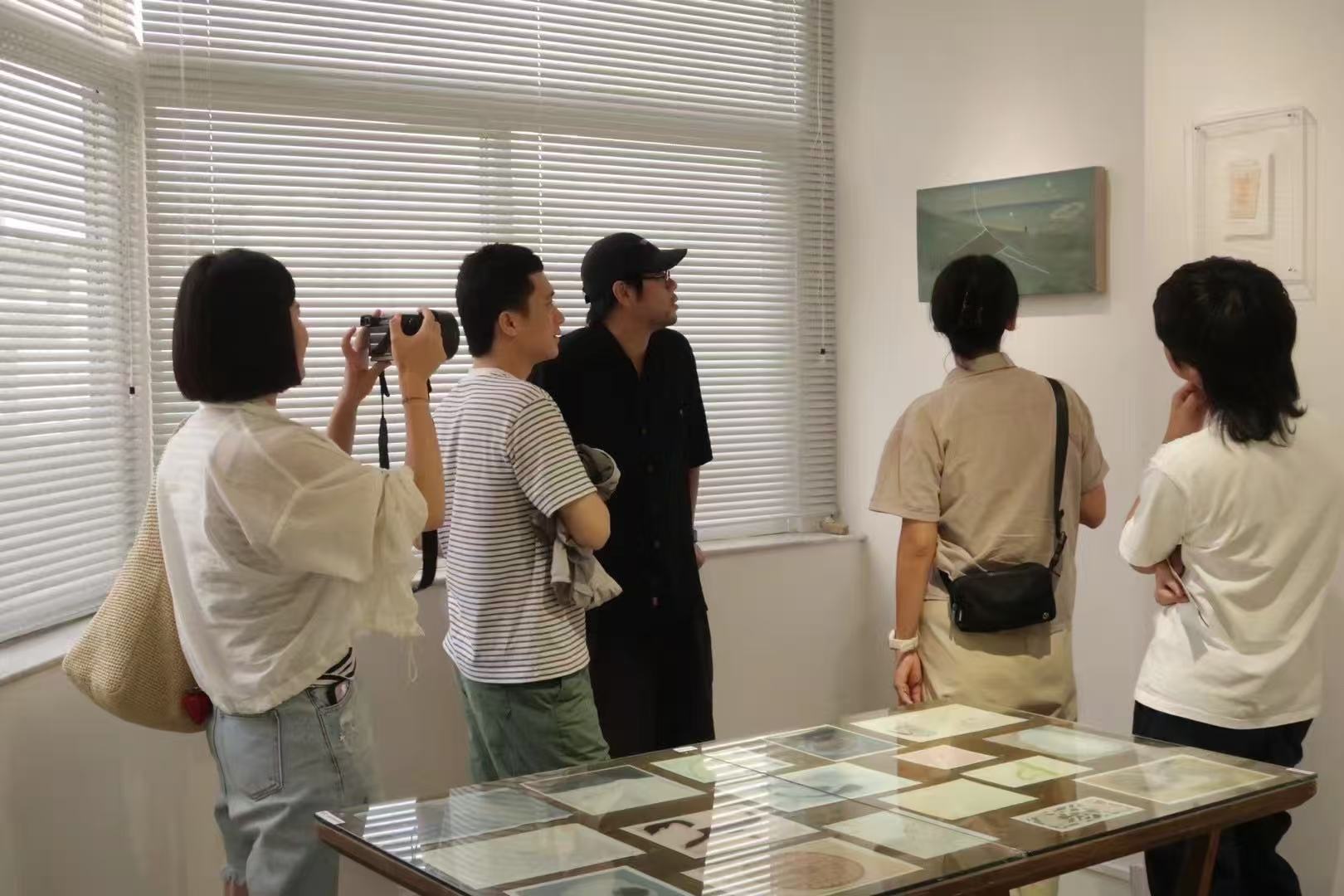
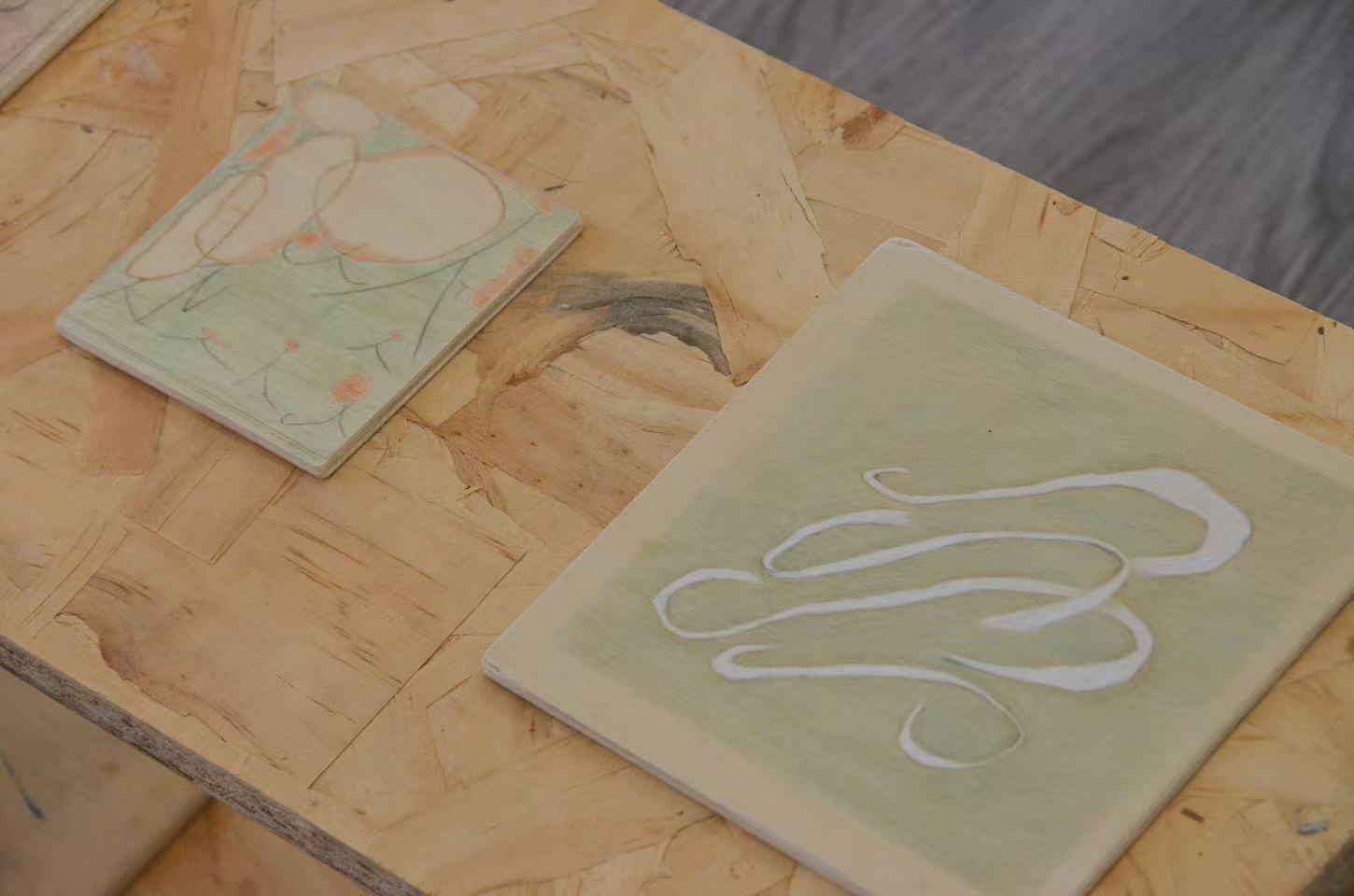
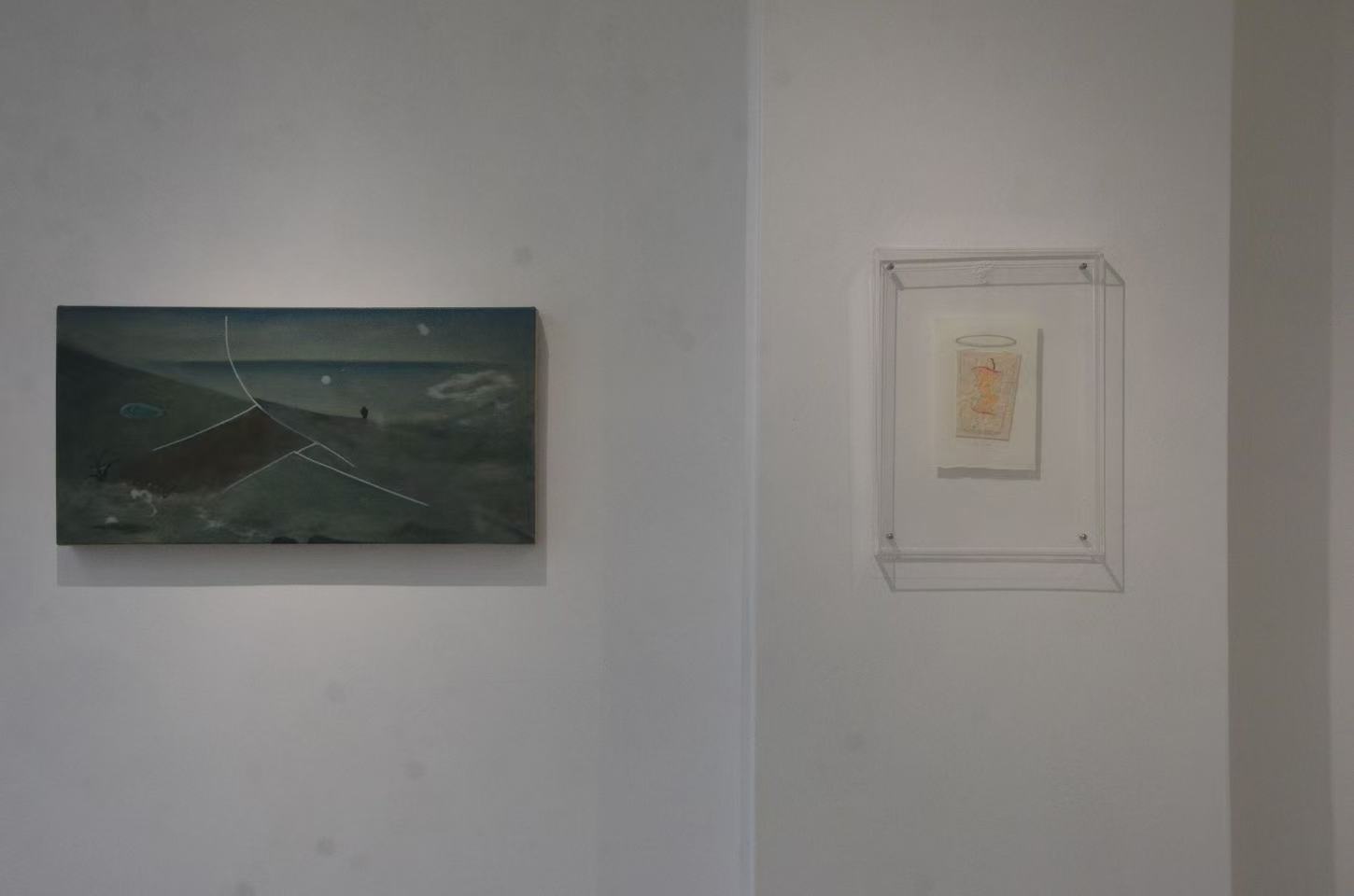
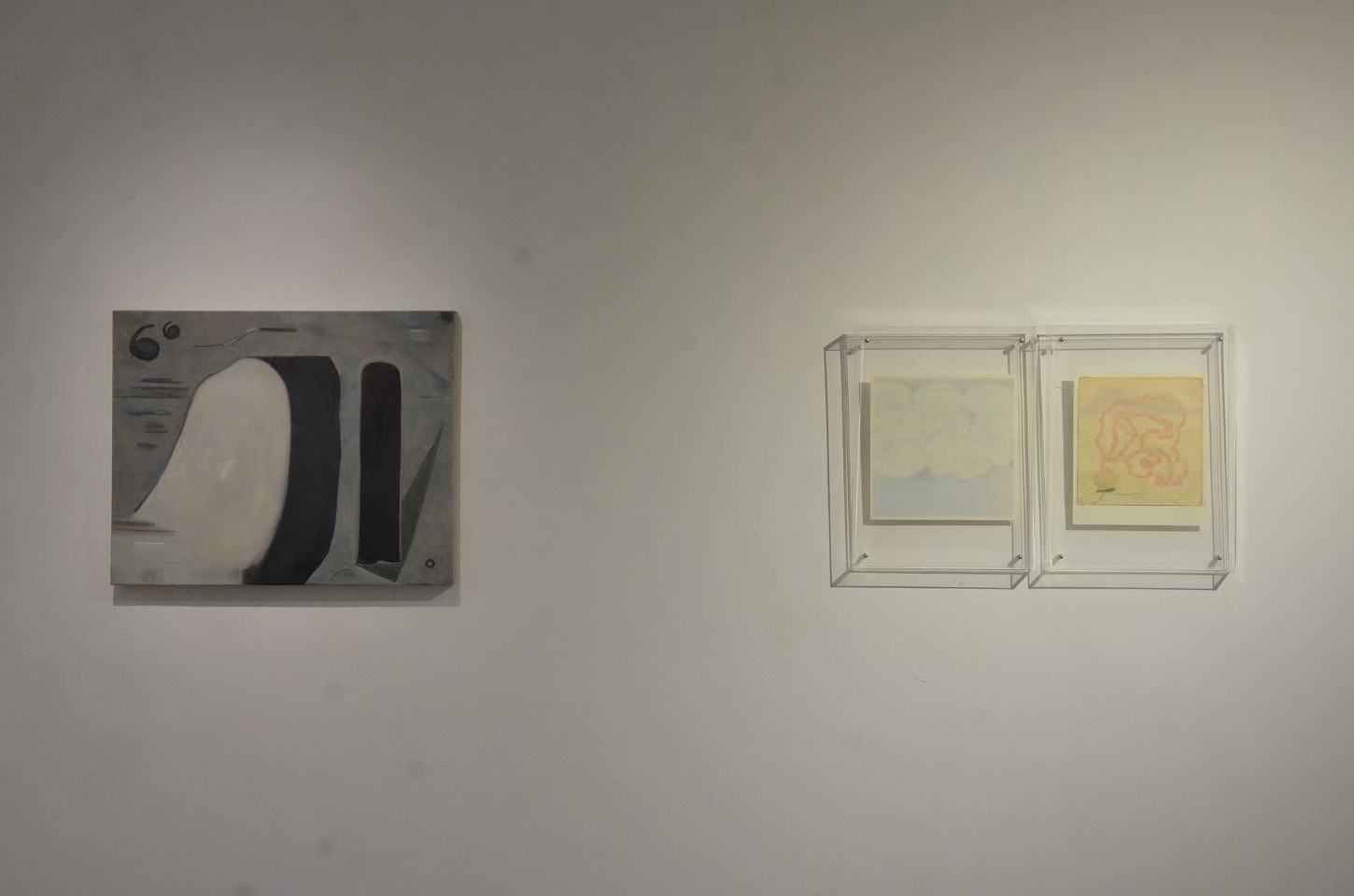
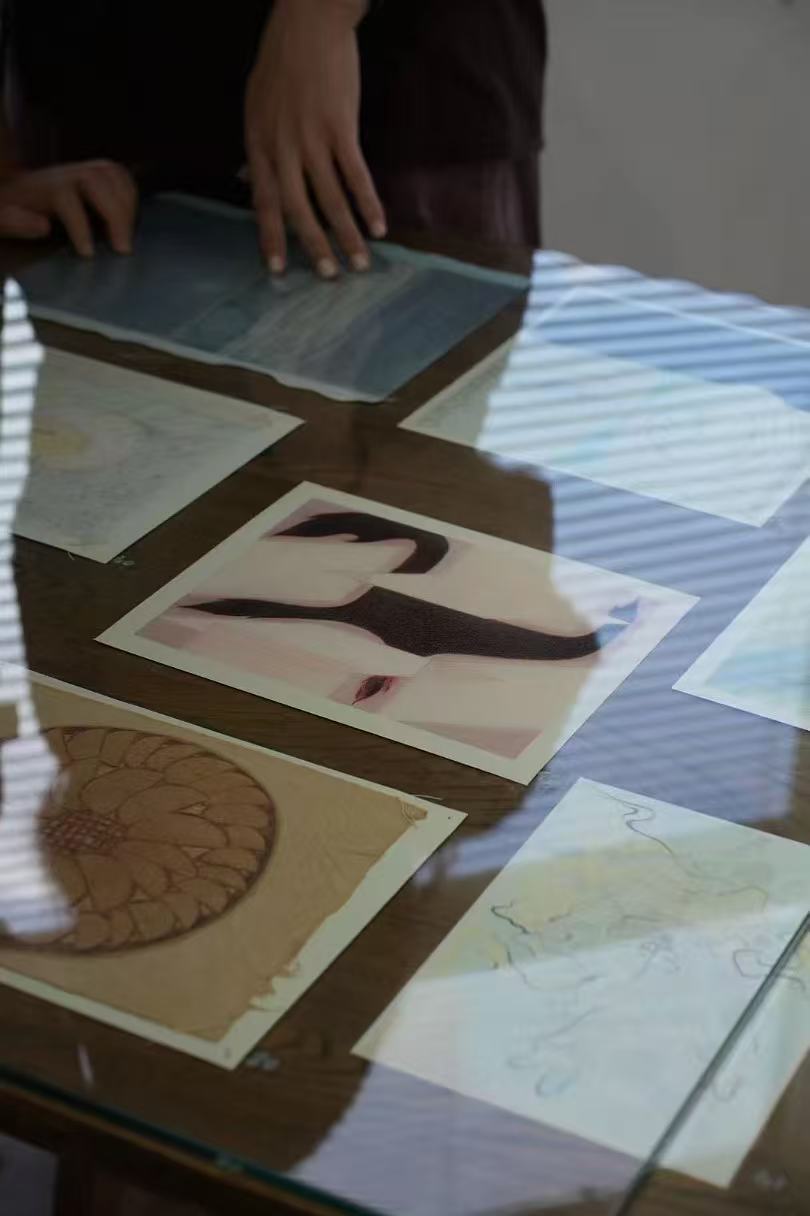
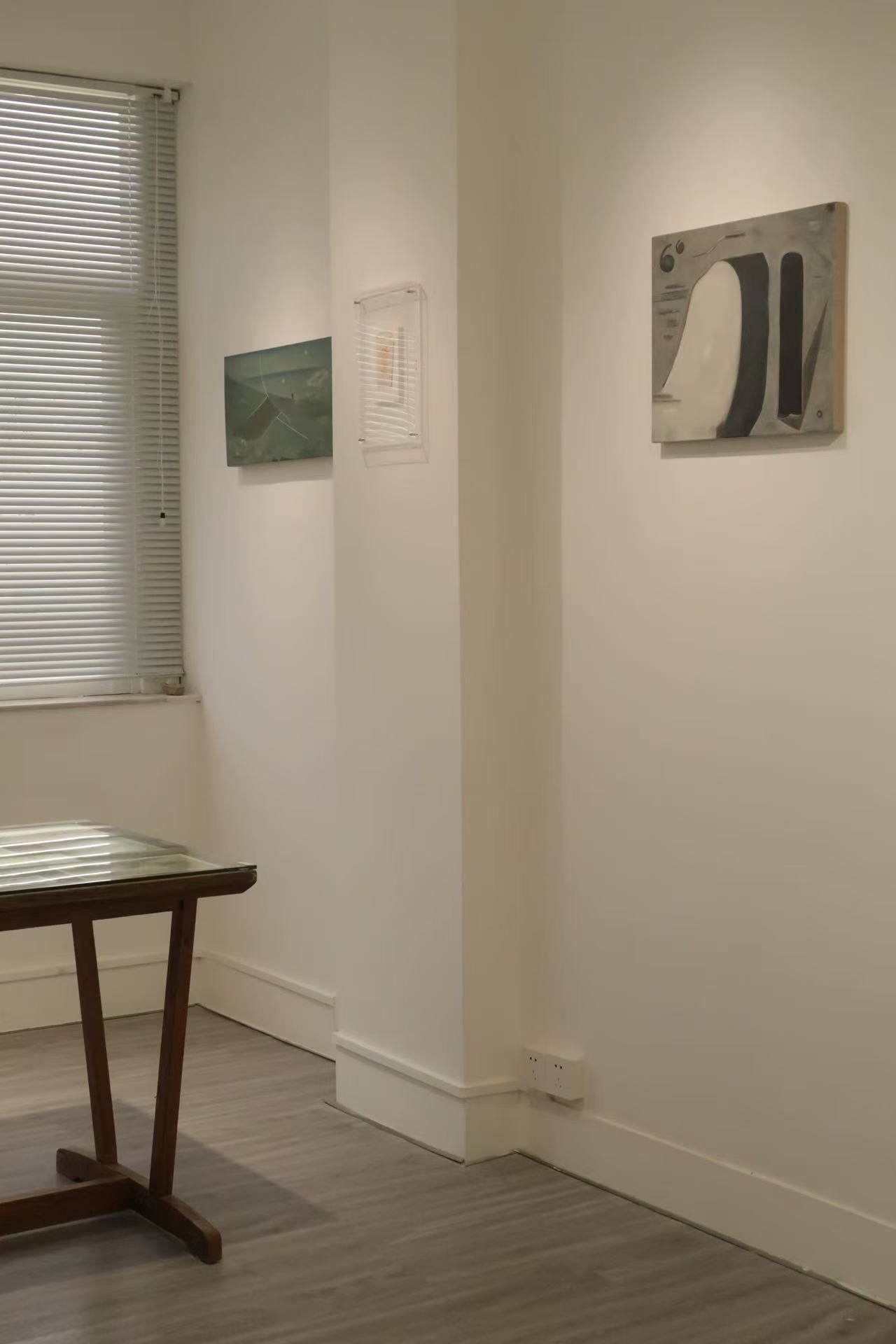
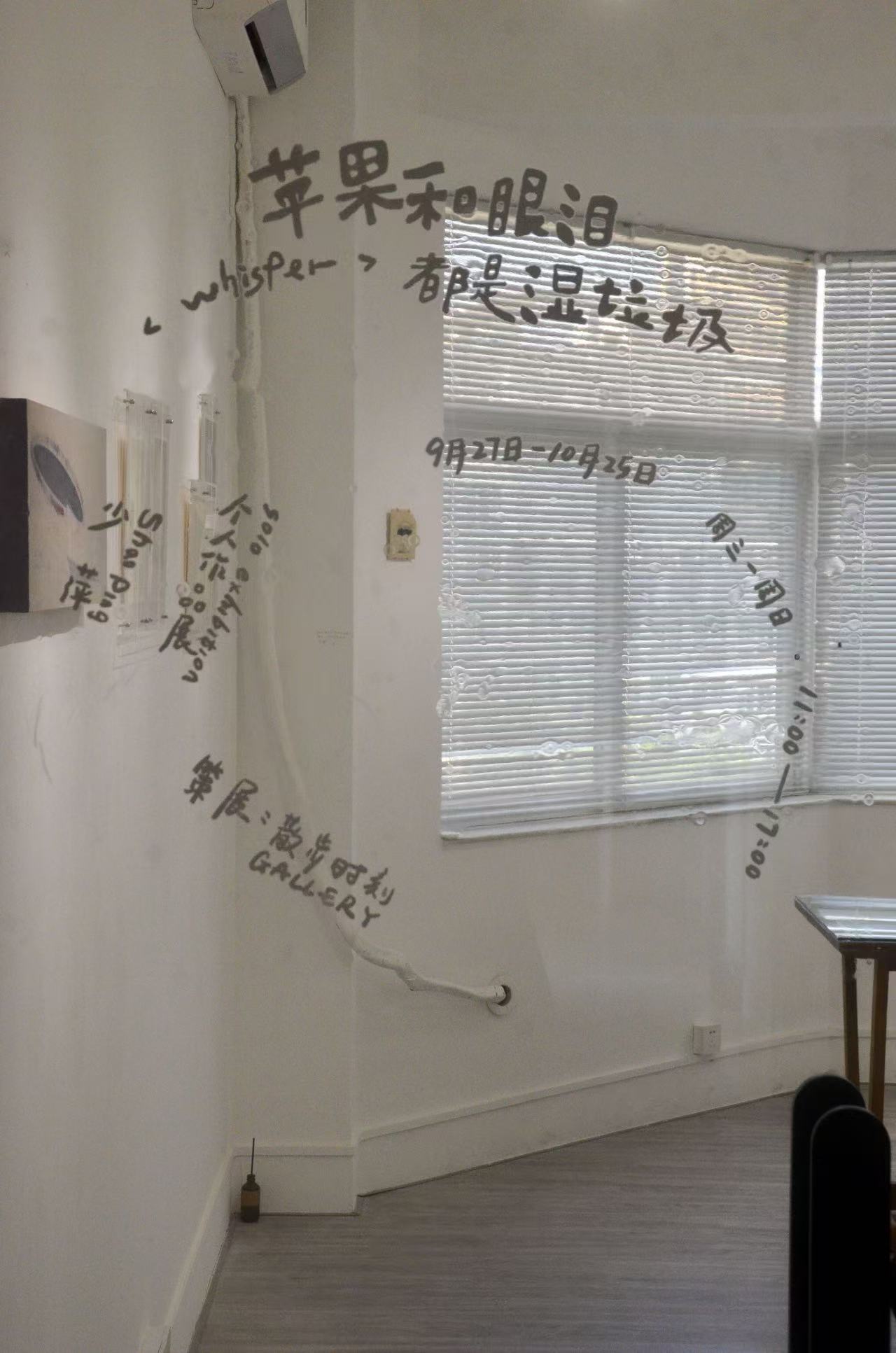
《苹果和眼泪都是湿垃圾 Whisper》|少萍个人作品展 ---(2025.09.27 - 10.25)
展言
什么是艺术?这是一个很大的问题。作为策展人也好,画廊主也罢,即便有这样的身份标签,也未必能够很好地去回答这个问题。在最近一次被问到时,我与采访者的答复是:艺术创作是日常里的一种“有氧”, 作品记录了过程,也呈现某种成果。艺术可能是人们面对生命和日常时的一种真诚的状态,在表达一个非常真实的自我。
从这个角度,艺术其实是私密的、是个人的。不是每个人都愿意将最真实的自己展示给别人看。艺术在撑起宏大叙事与人性共鸣的同时,它也来自一个非常私人、非常个体的地方。
散步时刻Gallery即将在9月底开启一场名为《苹果和眼泪都是湿垃圾》的个人作品展,艺术家少萍的创作脉络和大部分作品便是建立在个体情绪之上的艺术输出。
少萍犹如许多你我这般的城市青年,在上班与生活之间流转,栖息在一座都市心脏之中。很多时候,艺术创作是一种逃离,将自己封闭在一个人的绘画世界里。情绪的泥沼、微观的日常,一个朦胧的画面仿佛在脑海中游走。起初可能是不知在哪听到或是想起的一句话,散不去。然后落到了画面上,又回到脑子里,又回到纸上,反反复复的。
她的作品散发一种淡淡的表现性,静悄悄的笔触让每个画面有种如梦初醒的触动。走在情绪勾勒出来的一片山丘,夹在山坡与海平线之间,看着一颗不存在的月亮。艺术家的世界被久久地笼罩在一片由油画棒、色粉与彩铅所叙事的幽幽冷色调中。
石头、池塘、公园、一颗被削了皮的苹果,这些或许都是艺术家投射的自己。情绪被倾倒在白纸与画布上,象征物与关系持续被探索。画面中,一切都是交汇的、分离的。作品静候被打开,柔软的笔触等待被阅读。在这里可能找不到宇宙和山水,只有“渺小”的属于艺术家自己的个体叙事。
说回“什么是艺术?”——艺术源于生活,但它究竟源于生活里的什么?大家总觉得艺术源于生活里的美好。然而,我更加相信许多的艺术源于生活里的失落、不满、焦虑等等,各种外部世界泼在你我身上的负面物质。这些干扰着我们生活中的平静与规律,也在我们的脑海里催生各种噪音。波动的情绪与不完美的处境是常态,正因为这样,日常的困境反倒是滋养作品的催化剂。
有人喜欢挑战宏大的哲学叙事,也有人更关注自己的周遭,艺术家终究是一个多元化的群体。少萍运用轻轻的手法去包裹住个体在日常中强劲的呐喊。这种微妙、脆弱、随时可能崩塌的平衡,其实就特别的“艺术”,也是少萍作为艺术家的身上特别的东西。
....
《Whisper》Shao Ping Solo Exhibition
What is art? This is a profound question. Even with the professional identity of a curator or gallerist, one may still struggle to articulate it effectively. When recently asked this during an phone interview, my response to the interviewer was: Artistic creation serves as a form of daily "aerobic exercise" – an artist’s work often captures this creative process while showcasing tangible outcomes. Taking upon an authentic state of mind in the face of life and everyday experience, genuine expression of the self may be the true essence of art.
From this perspective, art is largely private and personal. Not everyone is willing to reveal their true selves to others. Thus, while art support grand narratives and human resonance, it also originates from a deeply individual space.
Opening at the end of September, Champochic Gallery's upcoming solo exhibition 《Whisper》 will showcase artist Shao Ping's creative trajectory and her work, predominately work that represent abstractions of her personal emotional experiences.
Shao Ping, like many urban youths, navigates between work and life, dwelling in the heart of a city. Often, artistic creation serves as an escape - a solitary retreat into her painting world. The emotional mire and close-up details of daily existence create fleeting visions that drift through her mind. What starts as an unforgettable phrase from somewhere she heard or remembered, might materialize on a canvas, then return to thoughts, then back and forth, endlessly repeating.
Her works exude a subtle expressiveness, with quiet brushstrokes creating dreamlike awakenings in each composition. Walking along a hill sculpted by emotions, sandwiched between slopes and the horizon, one gazes at a moon that never truly exists. The artist's world remains perpetually shrouded in a hazy, cool-toned narrative crafted with oil pastels, colored pencils, and crayons.
Stones, ponds, parks, and a peeled apple—these might all be projections of the artist's self. Emotions spill onto blank canvases, where symbolic elements and relationships are constantly explored. In some compositions, the elements are in a motion state of convergence, and divergence. Silently to be unveiled, soft brushstrokes awaiting interpretation. Here you won't find cosmic grandeur or mountain vistas—only the artist's personal narrative, small yet profound.
Returning to the question: "What is art?" ——Art originates from life, but what specific aspects of life does it draw from? While many believe art springs from life's beauty, I'm more convinced that much of it stems from life's disappointments, frustrations, anxieties, and the negative forces imposed upon us by the external world. They disrupt our inner peace and daily rhythms, creating mental noise that cloud our consciousness. Fluctuating moods and imperfect circumstances are commonplace—precisely because of this, life's everyday struggles become catalysts for good art.
While some may embrace grand philosophical narratives, others simply focus on their immediate surroundings. Artists ultimately form a diverse community. Shao Ping employs delicate techniques to encapsulate the powerful cries of individuals in the daily life. This subtle and fragile equilibrium that could crumble at any moment embodies an aspect of "art" – also a defining characteristic of Shao Ping's artistic identity.
什么是艺术?这是一个很大的问题。作为策展人也好,画廊主也罢,即便有这样的身份标签,也未必能够很好地去回答这个问题。在最近一次被问到时,我与采访者的答复是:艺术创作是日常里的一种“有氧”, 作品记录了过程,也呈现某种成果。艺术可能是人们面对生命和日常时的一种真诚的状态,在表达一个非常真实的自我。
从这个角度,艺术其实是私密的、是个人的。不是每个人都愿意将最真实的自己展示给别人看。艺术在撑起宏大叙事与人性共鸣的同时,它也来自一个非常私人、非常个体的地方。
散步时刻Gallery即将在9月底开启一场名为《苹果和眼泪都是湿垃圾》的个人作品展,艺术家少萍的创作脉络和大部分作品便是建立在个体情绪之上的艺术输出。
少萍犹如许多你我这般的城市青年,在上班与生活之间流转,栖息在一座都市心脏之中。很多时候,艺术创作是一种逃离,将自己封闭在一个人的绘画世界里。情绪的泥沼、微观的日常,一个朦胧的画面仿佛在脑海中游走。起初可能是不知在哪听到或是想起的一句话,散不去。然后落到了画面上,又回到脑子里,又回到纸上,反反复复的。
她的作品散发一种淡淡的表现性,静悄悄的笔触让每个画面有种如梦初醒的触动。走在情绪勾勒出来的一片山丘,夹在山坡与海平线之间,看着一颗不存在的月亮。艺术家的世界被久久地笼罩在一片由油画棒、色粉与彩铅所叙事的幽幽冷色调中。
石头、池塘、公园、一颗被削了皮的苹果,这些或许都是艺术家投射的自己。情绪被倾倒在白纸与画布上,象征物与关系持续被探索。画面中,一切都是交汇的、分离的。作品静候被打开,柔软的笔触等待被阅读。在这里可能找不到宇宙和山水,只有“渺小”的属于艺术家自己的个体叙事。
说回“什么是艺术?”——艺术源于生活,但它究竟源于生活里的什么?大家总觉得艺术源于生活里的美好。然而,我更加相信许多的艺术源于生活里的失落、不满、焦虑等等,各种外部世界泼在你我身上的负面物质。这些干扰着我们生活中的平静与规律,也在我们的脑海里催生各种噪音。波动的情绪与不完美的处境是常态,正因为这样,日常的困境反倒是滋养作品的催化剂。
有人喜欢挑战宏大的哲学叙事,也有人更关注自己的周遭,艺术家终究是一个多元化的群体。少萍运用轻轻的手法去包裹住个体在日常中强劲的呐喊。这种微妙、脆弱、随时可能崩塌的平衡,其实就特别的“艺术”,也是少萍作为艺术家的身上特别的东西。
....
《Whisper》Shao Ping Solo Exhibition
What is art? This is a profound question. Even with the professional identity of a curator or gallerist, one may still struggle to articulate it effectively. When recently asked this during an phone interview, my response to the interviewer was: Artistic creation serves as a form of daily "aerobic exercise" – an artist’s work often captures this creative process while showcasing tangible outcomes. Taking upon an authentic state of mind in the face of life and everyday experience, genuine expression of the self may be the true essence of art.
From this perspective, art is largely private and personal. Not everyone is willing to reveal their true selves to others. Thus, while art support grand narratives and human resonance, it also originates from a deeply individual space.
Opening at the end of September, Champochic Gallery's upcoming solo exhibition 《Whisper》 will showcase artist Shao Ping's creative trajectory and her work, predominately work that represent abstractions of her personal emotional experiences.
Shao Ping, like many urban youths, navigates between work and life, dwelling in the heart of a city. Often, artistic creation serves as an escape - a solitary retreat into her painting world. The emotional mire and close-up details of daily existence create fleeting visions that drift through her mind. What starts as an unforgettable phrase from somewhere she heard or remembered, might materialize on a canvas, then return to thoughts, then back and forth, endlessly repeating.
Her works exude a subtle expressiveness, with quiet brushstrokes creating dreamlike awakenings in each composition. Walking along a hill sculpted by emotions, sandwiched between slopes and the horizon, one gazes at a moon that never truly exists. The artist's world remains perpetually shrouded in a hazy, cool-toned narrative crafted with oil pastels, colored pencils, and crayons.
Stones, ponds, parks, and a peeled apple—these might all be projections of the artist's self. Emotions spill onto blank canvases, where symbolic elements and relationships are constantly explored. In some compositions, the elements are in a motion state of convergence, and divergence. Silently to be unveiled, soft brushstrokes awaiting interpretation. Here you won't find cosmic grandeur or mountain vistas—only the artist's personal narrative, small yet profound.
Returning to the question: "What is art?" ——Art originates from life, but what specific aspects of life does it draw from? While many believe art springs from life's beauty, I'm more convinced that much of it stems from life's disappointments, frustrations, anxieties, and the negative forces imposed upon us by the external world. They disrupt our inner peace and daily rhythms, creating mental noise that cloud our consciousness. Fluctuating moods and imperfect circumstances are commonplace—precisely because of this, life's everyday struggles become catalysts for good art.
While some may embrace grand philosophical narratives, others simply focus on their immediate surroundings. Artists ultimately form a diverse community. Shao Ping employs delicate techniques to encapsulate the powerful cries of individuals in the daily life. This subtle and fragile equilibrium that could crumble at any moment embodies an aspect of "art" – also a defining characteristic of Shao Ping's artistic identity.